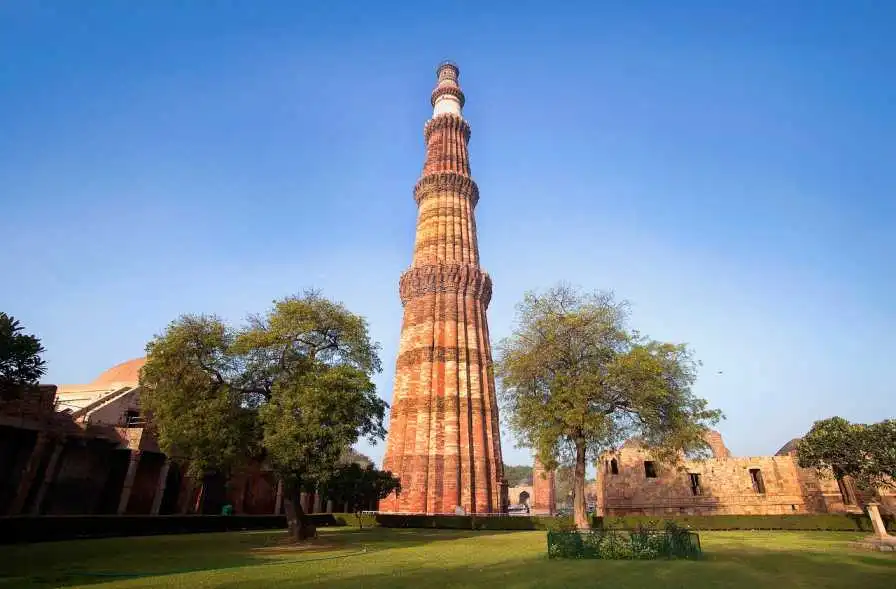Follow the trend

Qutub Minar, situated in Delhi, India, stands as a breathtaking symbol of the country's remarkable history and exceptional architectural prowess. As one of India's most renowned landmarks, this majestic tower has mesmerized countless visitors from across the globe. In this article, we will explore the historical importance, architectural highlights, UNESCO acknowledgement, intriguing facts, nearby attractions, and essential recommendations for experiencing the wonder of Qutub Minar.
Welcome to our exploration of Qutub Minar, a UNESCO World Heritage Site that showcases the grandeur of Islamic architecture in India. Standing at an impressive height of 73 meters (240 feet), this magnificent tower is surrounded by a complex that includes ancient ruins, a mosque, and other historical structures. Let's embark on a journey to uncover the captivating story behind this architectural marvel.
Qutub Minar was constructed in the 12th century by Qutb-ud-din Aibak, the founder of the Delhi Sultanate. The tower was initially built to celebrate the victory of Muhammad Ghori over the Rajput kingdom. Its architectural style is a blend of Indo-Islamic influences, characterized by intricate designs, ornamental motifs, and Islamic calligraphy.
Qutub Minar holds immense cultural importance in Indian history. It symbolizes the triumph of Islam in India and serves as a reminder of the country's multicultural heritage. The tower's five distinct storeys represent different rulers who contributed to its construction over the centuries.
Rising high into the sky, Qutub Minar stands as one of the tallest brick minarets in the world. The tower is divided into five storeys, each marked by intricately designed balconies. As you ascend the spiral staircase inside, you'll be greeted with mesmerizing views of the surrounding landscape.
The walls of Qutub Minar are adorned with intricate carvings and inscriptions, showcasing the mastery of craftsmanship during that era. These carvings depict verses from the Quran, floral patterns, and geometric designs. They serve as a testament to the architectural brilliance of the time.
Adjacent to Qutub Minar is the Quwwat-ul-Islam Mosque, one of the oldest surviving mosques in India. Built using the remnants of 27 Hindu and Jain temples, this mosque stands as a testament to the harmonious coexistence of different faiths during that period.
In 1993, Qutub Minar was designated as a UNESCO World Heritage Site, acknowledging its historical and cultural significance. This recognition has led to extensive preservation efforts, ensuring that future generations can continue to admire this architectural masterpiece.
Qutub Minar attracts a large number of tourists and history enthusiasts from around the globe. Visitors can explore the tower, soak in the majestic surroundings, and learn about the rich history of the site. The Qutub Festival, an annual cultural event held in the premises, further enhances the visitor experience with music and dance performances.
One fascinating aspect of the Qutub Minar complex is the Iron Pillar. Standing tall for over 1,600 years, this ancient iron pillar is known for its remarkable resistance to corrosion. It serves as a marvel of metallurgical expertise and continues to intrigue scientists and historians alike.
The Qutub Festival is a vibrant celebration of Indian classical music and dance. Held annually in the Qutub Minar complex, this cultural extravaganza brings together renowned artists who mesmerize audiences with their performances. It's a must-attend event for music lovers visiting Delhi.
Just a stone's throw away from Qutub Minar lies the Mehrauli Archaeological Park, a treasure trove of ancient structures, tombs, and monuments. Exploring this park offers a deeper understanding of Delhi's historical significance and its evolution over the centuries.
Not far from Qutub Minar, you'll find the Alai Minar, an unfinished structure that was intended to be twice the size of its counterpart. Although incomplete, the Alai Minar provides a glimpse into the grand vision of its builders.
Adjacent to Qutub Minar, the Iron Pillar Complex houses various smaller structures, including the Alai Darwaza and the Tomb of Imam Zamin. Exploring this complex adds further layers of historical richness to your visit.
Qutub Minar is open to visitors from morning until evening. It's advisable to check the opening hours in advance and arrive early to avoid crowds. Tickets can be purchased at the entrance, and there are separate rates for Indian and foreign tourists.
When you visit Qutub Minar, it is essential to dress in a modest and respectful manner, making sure to cover your shoulders and knees. Visitors are also requested to maintain a peaceful atmosphere and refrain from littering.
Photography enthusiasts will be delighted to capture the intricate details and panoramic views offered by Qutub Minar. However, it's important to be mindful of safety regulations and not to obstruct the flow of other visitors while taking pictures.
Qutub Minar stands as a proud testament to India's rich architectural heritage and cultural legacy. Its towering presence, intricate carvings, and historical significance continue to inspire awe and wonder. Visiting Qutub Minar offers a glimpse into the country's glorious past and provides an unforgettable experience for travelers seeking to immerse themselves in India's vibrant history.
Q1: Is there an entry fee for visiting Qutub Minar?
Yes, there is an entry fee for visiting Qutub Minar. The fee differs for tourists from India and those from other countries. It is advisable to check the current ticket prices before planning your visit.
Q2: How tall is Qutub Minar?
Qutub Minar stands at an impressive height of 73 meters (240 feet). This remarkable structure stands as one of the tallest minarets constructed with bricks globally.
Q3: Can visitors climb to the top of Qutub Minar?
Currently, visitors are not allowed to climb to the top of Qutub Minar for safety reasons. However, you can still admire its grandeur and explore the lower levels of the tower.
Q4: Are there any restrictions on photography within the complex?
Photography is allowed within the Qutub Minar complex. Visitors are free to capture the beauty of the monument and its surroundings. However, it is advisable to respect the privacy of other visitors and be mindful of any specific restrictions or guidelines provided by the authorities.
Q5: What are some nearby places to visit after exploring Qutub Minar?
After exploring Qutub Minar, you can visit the nearby Mehrauli Archaeological Park, which is known for its historical ruins and monuments. You can also explore the Alai Minar, an unfinished structure adjacent to Qutub Minar, and the Iron Pillar Complex, which houses several smaller structures of historical significance. These attractions offer a deeper understanding of Delhi's rich heritage and are worth exploring during your visit.
Your email address and mobile will not be published.




